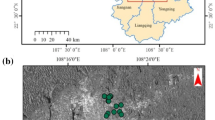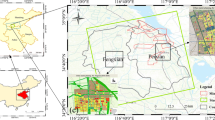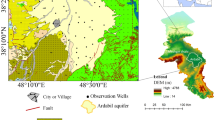Abstract
River delta plains (deltas) are susceptible to subsidence producing undesirable environmental impact and affecting dense population. The City of Shanghai, located in the easternmost of Yangtze Delta in China, is one of the most developed regions in China that experiences the greatest land subsidence. Excessive groundwater withdrawal is thought to be the primary cause of the land subsidence, but rapid urbanization and economic development, mass construction of skyscrapers, metro lines and highways are also contributing factors. In this paper, a spatial–temporal analysis of the land subsidence in Shanghai was performed with the help of the Small Baseline Subset Interferometric Synthetic Aperture Radar. Twenty l-band ALOS PALSAR images acquired during 2007–2010 were used to produce a linear deformation rate map and to derive time series of ground deformation. The results show homogeneous subsidence within the research area, but exceptionally rapid subsidence around skyscrapers, along metro lines, elevated roads and highways was also observed. Because groundwater exploitation and rapid urbanization responsible for much of the subsidence in the Shanghai region are expected to continue, future subsidence monitoring is warranted.











Similar content being viewed by others
Notes
Report on Shanghai’s economic and social development in 2012, Shanghai Statistics Bureau, http://www.stats-sh.gov.cn/sjfb/201302/253153.html.
Major agglomerations of the world, http://www.citypopulation.de/world/Agglomerations.html.
Buildings in Shanghai, http://www.emporis.com/city/shanghai-china/all-buildings/highrise.
Report on Shanghai’s economic and social development in 2012, Shanghai Statistics Bureau, http://www.stats-sh.gov.cn/sjfb/201302/253153.html.
Due to land subsidence in Shanghai one metro will be closed for repair, http://survincity.com/2012/08/due-to-land-subsidence-in-shanghai-one-metro-will/.
References
Amelung F, Galloway DL, Bell JW, Zebker HA, Laczniak RL (1999) Sensing the ups and downs of Las Vegas—InSAR reveals structural control of land subsidence and aquifer-system deformation. Geology 27(6):483–486
Bawden GW, Thatcher W, Stein RS, Hudnut KW, Peltzer G (2001) Tectonic contraction across Los Angeles after removal of groundwater pumping effects. Nature 412:812–815
Becker RH, Sultan M (2009) Land subsidence in the Nile delta: inferences from radar interferometry. Holocene 19(6):949–954
Berardino P, Fornaro G, Lanari R, Sansosti E (2002) A new algorithm for surface deformation monitoring based on small baseline differential SAR interferograms. IEEE Trans Geosci Remote Sens 40(11):2375–2383
Casu F, Manzo M, Lanari R (2006) A quantitative assessment of the SBAS algorithm performance for surface deformation retrieval from DInSAR data. Remote Sens Environ 102(3–4):195–210
Chen X, Zong Y (1998) Coastal erosion along the Changjiang deltaic shoreline, China: history and prospective, Estuarine. Coast Shelf Sci 46(5):733–742
Chen J, Wu J, Zhang L, Zou J, Liu G, Zhang R (2013) Deformation trend extraction based on multi-temporal InSAR in Shanghai. Remote Sens 5(4):1774–1786
Costantini M, Rosen P (1999) A generalized phase unwrapping approach for sparse data. Proceedings International Geoscience Remote Sensing Symposium, Hamburg, pp 267–269
Damoah-Afari P (2006) Detecting ground settlement of magacities using InSAR techniques. Dissertation. The Hong Kong Polytechnic University, Hong Kong
Deng B, Fan DD (2002) Sea level rise and its impact on sustainable development of Shanghai city. J Tongji Univ 30(11):1321–1325 [in Chinese]
Duzgun HS, Demirel N (2011) Remote sensing of the mine environment. CRC Press, Balkema, The Netherlands
El-Asmar HM, Hereher ME (2011) Change detection of the coastal zone east of the Nile Delta using remote sensing. Environ Earth Sci 62(4):769–777
Farr T, Kobrick M (2000) Shuttle radar topography mission produces a wealth of data. EOS Trans AGU 81:583–585
Ferretti A, Prati C, Rocca F (2001) Permanent scatterers in SAR interferometry. IEEE Trans Geosci Remote Sens 39(1):8–20
Gabriel AK, Goldstein RM, Zebker HA (1989) Mapping small elevation changes over large areas: differential radar interferometry. J Geophys Res 94(B7):9183–9191
Galloway DL, Hudnut KW, Ingebritsen SE, Phillips SP, Peltzer G, Rogez F, Rosen PA (1998) Detection of aquifer system compaction and land subsidence using interferometric synthetic aperture radar, Antelope Valley, Mojave Desert, California. Water Resour Res 34(10):2573–2585
Galloway D, Jones DR, Ingebritsen SE (Ed) (1999) Land Subsidence in the US. US Geological Survey, Circular 1182
Glowacka E, Sarychikhina O, Suarez F, Nava FA, Mellors R (2010) Anthropogenic subsidence in the Mexicali Valley, Baja California, Mexico, and slip on the Saltillo fault. Environ Earth Sci 59(7):1515–1524
Goldstein RM, Werner CL (1998) Radar interferogram filtering for geophysical applications. Geophys Res Lett 25(21):4035–4038
Hoffmann J, Zebker HA, Galloway DL, Amelung F (2001) Seasonal subsidence and rebound in Las Vegas Valley, Nevada, observed by synthetic aperture radar interferometry. Water Resour Res 37(6):1551–1566
Hooper A (2008) A multi-temporal InSAR method incorporating both persistent scatterer and small baseline approaches. Geophys Res Lett 35:L16302
Hu RL, Yue ZQ, Wang LC, Wang SJ (2004) Review on current status and challenging issues of land subsidence in China. Eng Geol 76(1–2):65–77
Hu J, Li Z, Ding X, Zhu J, Sun Q (2013) Spatial–temporal surface deformation of Los Angeles over 2003–2007 from weighted least squares DInSAR. Int J Appl Earth Obs Geoinf 21:484–492
Jiang L, Lin H, Cheng S (2011a) Monitoring and assessing reclamation settlement in coastal areas with advanced InSAR techniques: Macao city (China) case study. Int J Remote Sens 32(13):3565–3588
Jiang L, Lin H, Ma J, Kong B, Wang Y (2011b) Potential of small-baseline SAR interferometry for monitoring land subsidence related to underground coal fires: Wuda (Northern China) case study. Remote Sens Environ 115(2):257–268
Lanari R, Lundgren P, Manzo M, Casu F (2004a) Satellite radar interferometry time series analysis of surface deformation for Los Angeles, California. Geophys Res Lett 31(23):L23613
Lanari R, Mora O, Manunta M, Mallorqui JJ, Berardino P, Sansosti E (2004b) A small-baseline approach for investigating deformations on full-resolution differential SAR interferograms. Geosci Remote Sens 42(7):1377–1386
Lanaria R, Casua F, Manzoa M, Lundgrend P (2007) Application of the SBAS-DInSAR technique to fault creep: a case study of the Hayward fault, California. Remote Sens Environ 109(1):20–28
Lopez-Quiroz P, Doin MP, Tupin F, Briole P, Nicolas JM (2009) Time series analysis of Mexico City subsidence constrained by radar interferometry. J Appl Geophys 69(1):1–15
Massonnet D, Feigl KL (1998) Radar interferometry and its application to changes in the earth’s surface. Rev Geophys 36:441–500
Ng AHM, Ge L, Yan Y, Li X, Chang HC, Zhang K, Rizos C (2010) Mapping accumulated mine subsidence using small stack of SAR differential interferograms in the Southern coalfield of New South Wales, Australia. Eng Geol 115(1–2):1–15
Perissin D, Wang Z, Lin H (2012) Shanghai subway tunnels and highways monitoring through cosmo-skymed persistent scatterers. J Photogrammery Remote Sens 73:58–67
Samsonov S (2010) Topographic correction for ALOS PALSAR intergerometry. IEEE Trans Geosci Remote Sens 48(7):3020–3027
Samsonov S, Tiampo K, Gonzalez PJ, Manville V, Jolly G (2010) Ground deformation occurring in the city of Auckland, New Zealand, and observed by Envisat interferometric synthetic aperture radar during 2003–2007. J Geophys Res 115(B8):B08410
Samsonov S, van der Koij M, Tiampo K (2011) A simultaneous inversion for deformation rates and topographic errors of DInSAR data utilizing linear least square inversion technique. Comput Geosci 37(8):1083–1091
Samsonov S, d’Oreye N, Smets B (2013) Ground deformation associated with post-mining activity at the French–German border revealed by novel InSAR time series method. Int J Appl Earth Obs Geoinf 23:142–154
Schmidt DA, Bürgmann R (2003) Time dependent land uplift and subsidence in the Santa Clara Valley, California, from a large InSAR data set. J Geophys Res 108(B9):ETG 4–1–ETG 4–13
Shi X, Wu J, Ye S, Zhang Y, Xue Y, Wei Z, Li Q, Yu J (2008) Regional land subsidence simulation in Su-Xi-Chang area and Shanghai City, China. Eng Geol 100(1–2):27–42
Sneed M, Brandt JT (2007) Detection and measurement of land subsidence using global positioning system surveying and interferometric synthetic aperture radar, Coachella Valley, California, 1996–2005. Scientific Investigations Report 2007–5251. US Geological Survey. http://pubs.usgs.gov/sir/2007/5251/index.html. Accessed 21 July, 2013
Sun WS (2002) Investigation report on prevention and control of land subsidence in Yangtse Delta (in Chinese). In: Wei ZX, Li QF (eds) Proceedings of the national symposium on land subsidence. Shanghai Institute of Geology Survey, Shanghai, pp 1–12
Syvitski JPM, Kettner AJ, Overeem I, Hutton EWH, Hannon MT, Brakenridge GR, Day J et al (2009) Sinking deltas due to human activities. Nat Geosci 2(10):681–686
Tornqvist T, Wallace DJ, Storms JEA, Wallinga J, Van Dam RL, Blaauw M, Derksen MS, Klerks CJW, Meijneken C, Snijders MA (2008) Mississippi delta subsidence primarily caused by compaction of Holocene strata. Nat Geosci 1(3):173–176
Usai S (2003) A least squares database approach for SAR interferometric data. IEEE Trans Geosci Remote Sens 41(4):753–760
Wang JX, Feng B, Hu LS, Tang YQ, Yan XX, Wang HM, Liu JB (2013a) Application of geo-environmental capacity of ground building in urban planning. Environ Earth Sci 69(1):93–102
Wang G, Xie M, Chai X, Wang L, Dong C (2013b) D-InSAR-based landslide location and monitoring at Wudongde hydropower reservoir in China. Environ Earth Sci 69(8):2763–2777
Wegmuller U, Werner C (1997) Gamma SAR processor and interferometry software. Third ERS Symposium on Space at the Service of our Environment, Florence
Wu T, Kang JC, Li WJ, Meng F, An Y, Wang TT (2007) Advance of sea level change research in China. Maring Geol Quaternary Geol 27(4):123–130 [in Chinese]
Wu J, Shi X, Xue Y, Zhang Y, Wei Z, Yu J (2008) The development and control of the land subsidence in the Yangtze Delta, China. Environ Geol 55(8):1725–1735
Wu JC, Shi XQ, Ye SJ, Xue YQ, Zhang Y, Yu J (2009) Numerical simulation of land subsidence induced by groundwater overexploitation in Su-Xi-Chang area, China. Environ Geol 57(6):1409–1421
Wu J, Zhang L, Chen J, Li T (2012) Monitoring ground subsidence in Shanghai maglev area using two kinds of SAR data. J Appl Geodesy 6(3–4):209–213
Xu YS, Shen SL, Cai ZY, Zhou GY (2008) The state of land subsidence and prediction approaches due to groundwater withdrawal in China. Nat Hazards 45(1):123–135
Xue YQ, Zhang Y, Ye SJ, Wu JC, Li QF (2005) Land subsidence in China. Environ Geol 48:713–720
Zhang L, Wu J, Li T, Chen J (2012) Monitoring ground deformation based on small baseline approach in Shanghai. J Tongji Univ 40(10):1564–1568 [in Chinese]
Acknowledgments
The work in this paper was supported by China Scholarship Council (CSC) and Science National Foundation (NSFC: 41372353). The ALOS PALSAR data were provided by the Global Earth Observation Grid (GEO Grid, http://www.geogrid.org/en/index.html). Images were plotted with GMT and R software. We would like to thank four anonymous reviewers for their comments that helped us improve our paper.
Author information
Authors and Affiliations
Corresponding author
Rights and permissions
About this article
Cite this article
Dong, S., Samsonov, S., Yin, H. et al. Time-series analysis of subsidence associated with rapid urbanization in Shanghai, China measured with SBAS InSAR method. Environ Earth Sci 72, 677–691 (2014). https://doi.org/10.1007/s12665-013-2990-y
Received:
Accepted:
Published:
Issue Date:
DOI: https://doi.org/10.1007/s12665-013-2990-y




